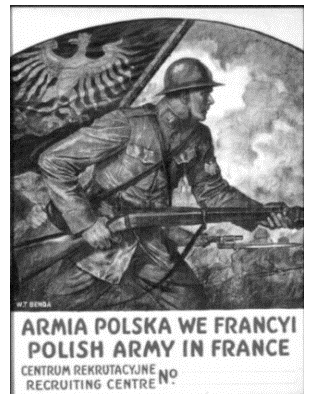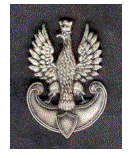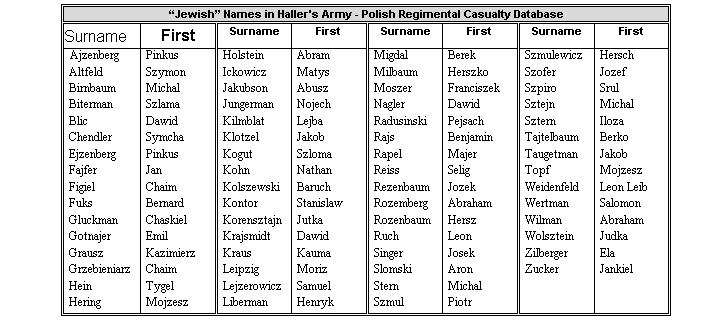Hallers Jews
Research History Hallers Jews
History
Jews in Haller's Army
Edward Goldstein
When my brother and I were growing up in Germany my father would sometimes tell us about his military service. He had been born and raised in Galicia, then part of the Austro-Hungarian Empire. In 1913, he was drafted into a Polish-speaking unit of the Austrian Army and, during the first World War, fought on the Italian front. In 1917 he became an Italian prisoner of war along with tens of thousands of his comrades. In late 1918 he was recruited into Haller’s Army as an adjutant and sent first to France for training and then to newly independent Poland to fight against Ukrainians and the Red Army. (In the American Army, “adjutant” is a job description but, as I found out during my research, in the French and Polish Armies it designates a military rank above that of a non-commissioned officer, but below a second lieutenant.)

![]()
I now regret greatly that neither my brother nor I ever took much interest in these stories. They seemed like ancient history and of no great relevance to the turmoil we experienced during the Hitler years. We did not ask him many questions, but I remember clearly the pride he felt in his years as a soldier, especially those as an officer in Haller’s Army. In his later years, he shared a few military documents and a medal with his grandchildren.
About a year or two ago, having reached an impasse in tracing my parents’ family lineages, I decided to look into that part of my father’s life and began to research Haller’s Army.
An Internet search produced a great deal of material, some of it greatly disturbing. For among the information about its origins and its uniforms and battles there were numerous reports of pogroms and other anti-Semitic activities perpetrated by members of that organization.
I checked the Encyclopedia Judaica and found that its definition begins as follows:
“HALLER'S ARMY ("Blue Army"), force of Polish volunteers organized in France during the last year of World War I, responsible for the murder of Jews and anti-Jewish pogroms in Galicia and the Ukraine…”
How was I to reconcile these reports with my father’s obvious pride at having been a Hallerczyk (informal Polish for a member of Haller’s Army)? I decided to dig deeper.
What Was Haller’s Army?
During the last quarter of the 18th century Poland, once one of the strongest and largest countries in Europe, was divided among Russia, Austria and Prussia and ceased to exist as a country until its reconstitution at the end of the first World War.
During that war, a number of “Polish” military units fought on both sides of the conflict. Russia fielded the army known as the Polish “Lancers.” Austria provided training for Pilsudski’s “Legions.” And France provided support for the creation of a well-trained, well-equipped, modern army, the equal of any army afield in those days. It became officially known as the Polish Army in France. When General Jozef Haller, who had commanded one of Pilsudski’s “Legions,” was appointed its commander its popular name became Haller’s Army.
Haller’s Army was financed and organized by the French government, as well as Polish émigré organizations. Most of its 100,000 or so soldiers were recruited from among Poles who had emigrated to the United States. It also contained remnants of the Polish Legion that had made its way from Russia to France with General Haller, as well as Poles from other countries.
In April 1919, Haller and his army went to Poland and, between 1919 and 1921, fought both the Ukrainians in Eastern Galicia and the Bolsheviks in Eastern Poland, Lithuania and Belarus. These battles were instrumental in keeping the Bolsheviks out of Poland and in making eastern Galicia a part of Poland rather than Ukraine.
Eastern Poland, Lithuania and Belarus. These battles were instrumental in keeping the Bolsheviks out of Poland and in making eastern Galicia a part of Poland rather than Ukraine.
It was during this period that the reported anti-Semitic incidents occurred. To put things in context, however, I should note that there are also several reports of Hallerczyki attacking Ukrainian civilians. In fact, some of the attacks on Jews seem to have been justified by the allegations that they had collaborated with the Ukrainian (and Bolshevik) military units that at various times had briefly occupied parts of Galicia and whom Haller’s Army had expelled.
Sources of Recruits
Before the Armistice in November 1918, the bulk of Haller's Army came from:
Ø Tens of thousands of volunteers from among Poles living in the United States.
Ø Remnants of the Bayonne Legion, consisting of Polish members of the French Foreign Legion; this unit had suffered severe casualties earlier in the war.
Ø Remnants of one division of the Polish Legion under Haller’s command; it had fought on Germany’s side, then participated in the chaotic warfare that followed the Bolshevik revolution. With British help, they made their way to France via Murmansk.
Ø Poles from South America, predominantly Brazil.
Ø Volunteers recruited in Allied POW camps.
After Haller's Army made its way to Poland. It filled its ranks with:
Ø Poles conscripted by the government of newly independent Poland.
Ø Other units of the Polish Army, mainly those manned by Polish soldiers who had served in other armies during the war.
Ø Volunteers from within Poland.

As a result, during the time it did its fighting in Poland — between 1919 and 1921 — Haller’s Army was far from homogeneous. Its officers and soldiers had come from factory and farm, from university and tailor shop, from shtetl and metropolis. They had been raised under the Czar or the German or Austrian Kaiser, or
![]() even abroad. Many had served under the military discipline of the German or Russian or Austrian armies or of none. Some of its units had been trained by French officers using the most up-to-date military doctrine, others hardly deserved to be called military. Some of its soldiers had been bloodied in severe fighting, others were green recruits.
even abroad. Many had served under the military discipline of the German or Russian or Austrian armies or of none. Some of its units had been trained by French officers using the most up-to-date military doctrine, others hardly deserved to be called military. Some of its soldiers had been bloodied in severe fighting, others were green recruits.
Other Jews in Haller’s Army
In order to find out if my father had been unique as a Jewish Hallerczyk I searched the Internet using a variety of search terms. I could find no reference to the general subject of Jews in Haller’s Army. But I did find biographies of two Jews who were incidentally identified as having served as Hallercyki (plural of Hallerczyk):
Ø Juliusz Pawel Schauder was born in Lwow on September 25, 1899 as a son of Regina and Zygmunt Schauder. His father was a lawyer in Lwów and also in Rohatyn where Juliusz attended primary school. In 1917, at the regular age of 18, Juliusz finished secondary school in Lwów and immediately afterwards was drafted into the Austrian army. He was sent to the Italian front and fought there until he was captured by the Italians as a prisoner-of-war. After the armistice 27,000 of the Austrian prisoners-of-war of Polish nationalily in Italy volunteered to join the Polish Army organized in France, and among them was Juliusz Schauder. With this army, the so-called Haller's Blue Army, he returned to Poland in 1919. His military service ended the same year, and in the fall he started to study mathematics and physics at the Jan Kazimierz University of Lwów.
(From “Juliusz Schauder—Personal Reminiscences, by R. S. Ingarden” at http://www.mat.uni.torun.pl/~tmna/htmls/mem1.html)
Ø David Baldinger was the screenwriter and film director Billie Wilder’s favorite uncle. The Baldinger family came from the area of Zakopane in the extreme western part of Galicia. Billie’s father’s family was from eastern Galicia. David, trained as an engineer and fought in Haller's Army during the war of independence for Poland.
I then posted queries on various bulletin boards dealing with Jewish and Eastern European genealogy. I received one response, from a Holocaust survivor named Joe Sachs. Following are two excerpts from our email correspondence:
It may come as a surprise to many, but this is fact. Inasmuch as the Haller army had a reputation of virulent anti-Semitism, Jews did serve in that branch of the Polish Army on the Eastern Front, my father [Jakob Saks] being one of those. He was drafted right after the declaration of independence and sent off to fight in 1920 and '21.
… my father's initial service in the Haller unit I obviously did not witness for I was born in 1926 nearly four years after he returned from the Eastern Front in Poland. I do recall vividly his annual trips to unit reunions and victory celebrations that took place in the larger cities, to one of which he brought me. On 2 September 1939, as we were fleeing to the east away from our home in Sosnowiec, my father packed and carried his military gear along for the rendez-vous with his unit, until the advancing German army overwhelmed the train we were on, which was when he rid himself of all Polish military I.D's
Here was obviously one other Jewish Hallerczyk who had taken pride in his service. How else would one explain “his annual trips to unit reunions and victory celebrations” and the fact that he took his small son to one of them?
Jews on Regimental Casualty Lists
The PolishRoots web site at www.polishroots.org contains much material of interest to genealogical researchers; you may have seen references to it in past issues of The Galitzianer. One of its databases is titled “Haller’s Army: Polish Regimental Casualty List.” It was compiled by Paul Valasek.
The introduction to the database describes its contents as follows:
This list of casualties is extracted from Polish Regimental Histories written within 10 years of the end of the Polish-Soviet war of 1918-1920. These casualties are of men who were killed or died from wounds in battle both on the Western and Eastern Fronts. Some data includes casualties sustained in units fighting in France up to the Armistice of November 11, 1918. Many others are casualties that occurred after the French campaigns and include fighting in Poland, Ukraine, and Volhynia (Wolynia) [i.e., Eastern Galicia], up to 1921.

I had previously corresponded with Paul in connection with an article in The Galitzianer. He had mentioned that his grandfather had served in Haller’s Army and I had told him about my father’s service. I now asked him if he had any information about Jews who had been Hallerczyki. He had no direct information but told me that he thought some of the names in the casualty list sounded “Jewish.”
I decided to take a look at these names myself. I found that it is possible to display all the information about the 1,381 names on that list by simply leaving the search fields blank and clicking the SEARCH button.
I extracted all the names from the list and visually scanned them. I eliminated all the names I did not think were Jewish taking account of both last and first names in these judgments.
Now, as every researcher knows, the definition of what constitutes a “Jewish” name is a slippery one. Individuals with “Jewish” names often turn out to be anything but Jewish, and vice versa. But it is hard to imagine that names like Schmul Salcman and Pinkus Ajzenberg belonged to anyone but Jews. (I asked Fred Hoffman, author of Polish Surnames: Origins and Meaning, to identify those names he thought might be “Jewish”; his list overlapped mine almost completely.)
You can make up your own mind on that subject. The individuals whose names I judged to be probably Jewish are listed in the table above. Note there are 62 of the total 1,381 individuals, or about 5%, on that list. If the ratio of Jews to non-Jews is roughly the same for the entire organization and if we assume the size of Haller’s Army to have been roughly 100,000, we can reasonably conclude that it had several thousand Jewish members.
Some Troubling Questions
Based on the evidence I have considered I conclude that: (1) individual Hallerczyki and probably units of Haller’s Army committed anti-Semitic atrocities while in Poland, and (2) thousands of Jews served in Haller’s Army.
Troubling questions arise regarding what these Jewish Hallerczyki were doing while their comrades were committing anti-Semitic atrocities.
First of all we have to ask if any of them were present when these atrocities occurred.
Lacking any evidence to the contrary, I will assume that the units to which the two Jewish Hallerczyki about whom we know some details—Jakob Saks and my father—did not commit any of these atrocities. (Obviously, I may not be entirely objective here.)
But for the others we can speculate about many possible scenarios: Perhaps units containing Jews were, for one reason or another, less likely to commit such atrocities; perhaps the number of atrocities committed by Hallerczyki has been exaggerated; perhaps Hallerczyki were sometimes blamed for atrocities committed by other units of the Polish army or the various paramilitary gangs infesting the countryside.
But I don’t think that we can reasonably assume that none of the units that included Jewish Hallerczyki engaged in these atrocities. Or that none of the Jewish soldiers were present on any such occasions.
Did any that were present participate, either willingly or unwillingly? Did they look the other way? Did they try to stop their fellow soldiers? How did they feel? How did they relate to their comrades afterward? Were they also victimized by their comrades?
And what did the Jewish officers and non-commissioned officers feel and do under these circumstances? (Among the names I had identified as “Jewish” on the casualty list there was one Lieutenant and one Sergeant. My father was an officer. It is reasonable to assume that quite a few other Jews were also.)
The Pogrom at Lida
Lida is located in Belaruss. In 1921 it had a population of 13,400 individuals, of whom 5,419 were Jews.
Lost Jewish Worlds—Lida, published by Yad Vashem reports the following incident:
On Passover eve in 1919, the Polish army entered Lida and the soldiers of General Haller mounted a pogrom in which thirty-nine Jews were murdered.
In 1921, Passover eve occurred on 14 April. But Stanley R. Pliska, in an authoritative account of the history of Haller’s Army (The “Polish-American Army” 1917-1921), states:
…it was not till April 1919, that this army … was finally moved [from France] to Poland.
It is legitimate to speculate whether, after its long journey, Haller’s Army would have been ready to commit this atrocity or whether perhaps someone else bore responsibility for it.
I cite this incident only to provide some support for my earlier speculation that Hallerczyki might at times have been blamed for crimes carried out by others. When recalling the horrific facts of a pogrom, perhaps years after the fact, a narrator might be excused not accurately recalling the specific military affiliation of its perpetrators.
Conclusion
When I finished the research for this article I had answered many of the easy questions with which I started—the facts and figures. But new—and more difficult—questions appeared with each draft as I tried to put the things that I had learned into context.
What I found out from diligent internet research, trips to libraries, and email discussions with several individuals familiar with published sources on modern Polish history was that the subject of Jews who served in Haller’s Army is apparently virgin territory as far as historical research is concerned.
If any of our readers have additional information, especially contemporaneous documentation or stories they may have heard from relatives, about the Jews who served in Haller’s Army, I ask them to get in touch with me at Edward.TheG@verizon.net. If any significant new material turns up I promise to publish it in a future issue of The Galitzianer.
I am grateful to the following individuals who helped with information and advice for this article: Dr. Paul Valasek VP of PolishRoots.org, a director of the Polish Museum of America and a past president of the Polish Genealogical Society of America; William F. (Fred) Hoffman, author (among other works) of Polish Surnames: Origins & Meanings, published by the Polish Genealogical Society of America, and editor of Gen Dobry!, the e-zine of PolishRoots™; and Professor Piotr Wróbel of the University of Toronto, author of nine books and over 50 scholarly articles, including The Jews of Galicia under Austrian-Polish Rule, 1867–1918 that appeared in recent issues of The Galitzianer.Copyright © 2002 Edward Goldstein. All rights reserved. Used by Permission of the author.
This article is reprinted from The Galitzianer, the quarterly journal of Gesher Galicia, May 2002.
;
